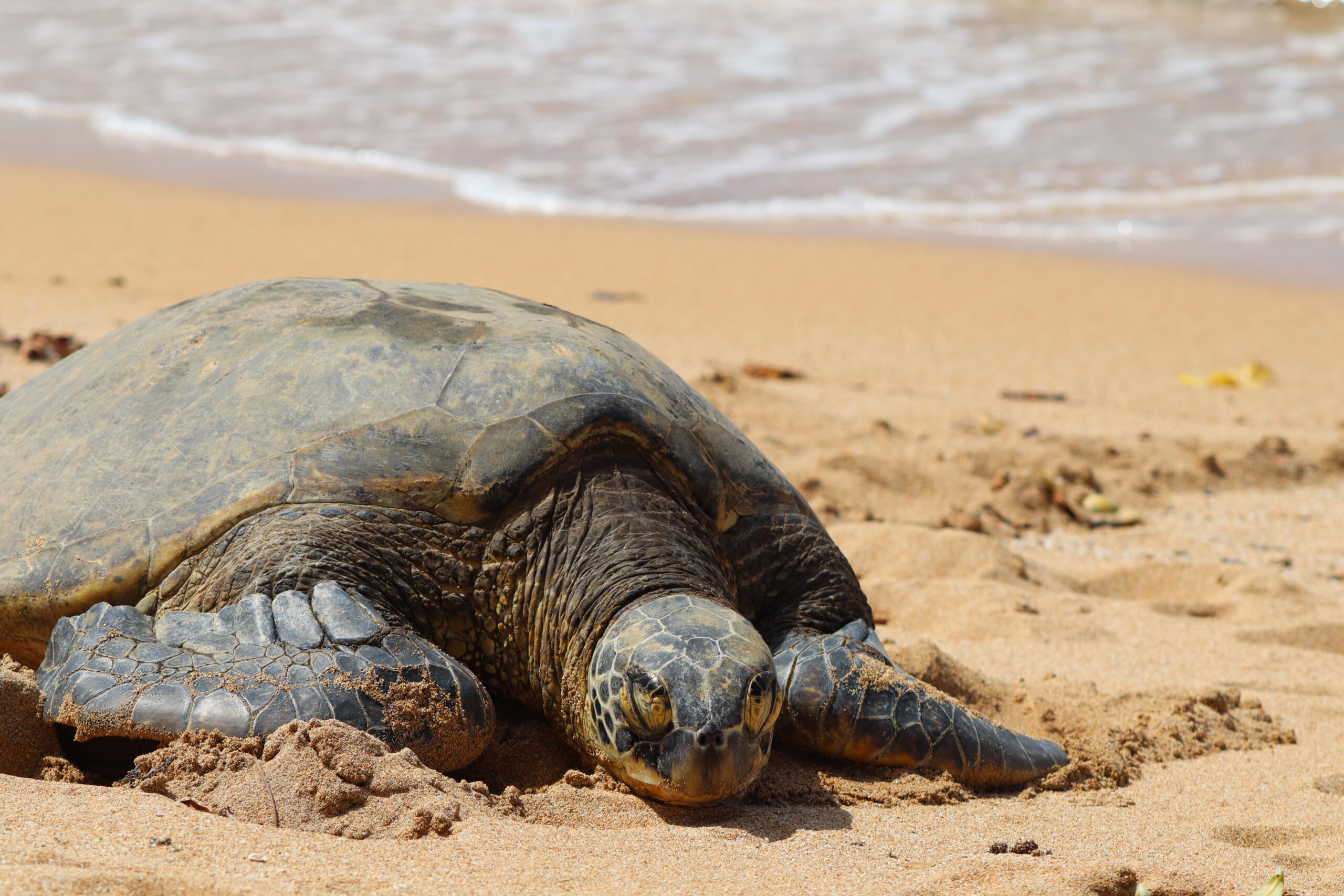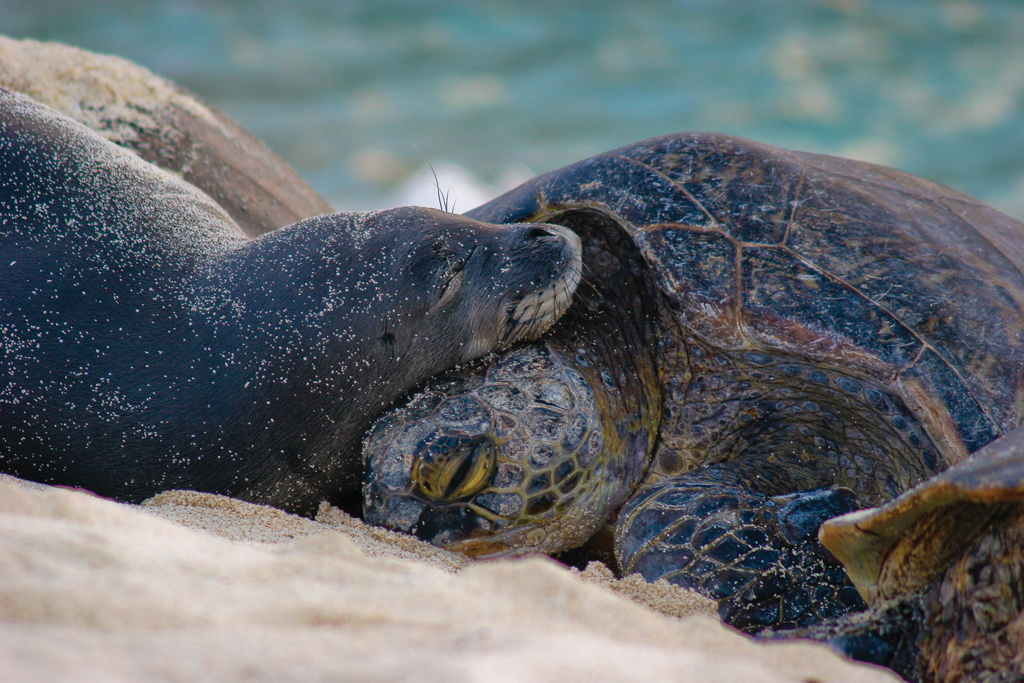An Ocean of Plastic: Problems and Solutions
An Ocean of Plastic: Problems and Solutions
By Devon Stapleton
The Plastic Problem
There has been a scary metric spreading across many media platforms that there will be more plastic in the ocean than fish by the year 2050 (Ellen Macarthur Foundation, 2016). Where is this plastic coming from and how do we stop the pervasive nature of this global issue? “Plastics,” is a very broad term that describes human made waste that persists in a marine environment (NOAA, 2008). Plastic is just one kind of marine debris, too. Marine debris could be as small as microscopic plastic that is not visible with the human eye to a sunken ship. But, the one thing that all marine debris have in common is their impact on the natural environment, and on many marine species.
Marine debris comes from numerous different sources, such as mismanagement of landfill, littering on land where rain and winds can carry the debris into the ocean, and disposal at sea. A surprising but significant source is fishing boats that either deliberately or accidentally lose their fishing lines, hooks, and nets (Lebreton et al. 2018). This is a global issue, but is extremely prevalent in Hawaii because the islands are in the middle of the Pacific Ocean, placed at the bottom of the North Pacific Subtropical Gyre. Nearly 60% of the marine debris measured in a recent study was found to float because it is less dense than the saltwater (Lebreton et al. 2018). Oceanic currents and winds transport plastic marine debris to other parts of the ocean or back onto coastlines. The plastics can break down over time into smaller pieces depending on conditions like sunlight exposure and waves. Due to unique current systems there is a large amount of the marine debris in the ocean that accumulates in the Pacific between Hawaii and California, also known as the Great Pacific Garbage Patch (Lebreton et al. 2018). These currents are also pushing significant amounts of marine debris to Hawaii’s coastlines and beaches.
Marine debris is not only polluting Hawaii’s iconic beaches, but it is impacting the local marine species such as Hawaiian monk seals, Hawaiian green sea turtles, spinner dolphins, humpback whales, seabirds, and other marine life in the region. Smaller species can mistake smaller broken down plastics as food and consume or filter feed it. Larger species will then consume many of these smaller species, which means plastic can move up the food chain. The seafood that we eat are top predators that have consumed plastics through this process, meaning we can consume those microscopic plastics as well (NOAA, 2020). The Monterey Bay Aquarium Seafood Watch Program that recommends more sustainable seafood options. Plastic consumption is just one marine debris impact though. There is also the issue of marine debris entanglement, especially in fishing gear. This often occurs with the Hawaiian monk seals, Hawaiian green sea turtles, spinner dolphins, humpback whales in Hawaii, causing them to either be unable to swim, breathe, or other threats to survival. This can exhaust them and lessen or stop their abilities to eat food for survival.
How can you help as an individual?
While marine debris is a growing threat, there is a lot each individual person can do to help. The first way to combat marine debris from getting into the ocean is by limiting the amount of plastic that is used in our daily lives. The “zero waste movement” has been growing over the past 5 years, which encourages people to significantly lessen the amount of waste they produce.
- The first step to reducing your waste is using what you already have. There are many new and exciting zero waste products that can now be purchased, but remember the most sustainable products are what you already own.
- As you consider replacing items, look for plastic free alternatives. Each day there are new alternatives being made, like shampoo and conditioner bars that lather and clean the same, but do not come in plastic containers. There’s makeup in bamboo containers now, toothpaste tablets, and even reusable Q-tips. Many are familiar with reusable straws, but plastic straws are a actually a small contributor to the plastics that end up in the ocean (NOAA, 2020). When it’s an option saying no to single use plastics is ideal, but plastic utensils, ziplock bags, and take out bags can be reused multiple times. There are zero waste options like beeswax paper that replace plastic wrap, bamboo utensil kits that replace plastic utensils, and bamboo brushes and dish soap bars.
- Vote with your dollar. You can support the changes you want to see by voting with your dollar. As these sustainable options become more popular they become cheaper and it encourages other companies to follow their lead.
- Shop locally. You can also help by shopping local, which reduces carbon emissions. If that’s not an option, you can support companies that use low-waste packaging and carbon offset their shipments.
- Advocate and participate. If you want to help in a more direct way, you can! Participating in organized or personal beach clean ups helps remove plastics out of the environment. As an HMAR volunteer, you can participate in community conservation measures and help make a difference. You can also talk to companies, big or small, and let them know that sustainable business practices are a priority for you as a consumer. Another option is to vote for climate leadership to make larger-scale changes in your community and country. The final large way to make change is through educating others on this issue and ways they can help.
Working towards reducing or eliminating plastics in the ocean is not about being perfect, it is about making small changes that can hopefully make a big difference. All of these small changes add up to a significant positive impact for our oceans and the marine animals we care about.
Work Cited:
- Lebreton, L., et al. “Evidence That the Great Pacific Garbage Patch Is Rapidly Accumulating
Plastic.” Nature News, Nature Publishing Group, 22 Mar. 2018, www.nature.com/articles/s41598-018-22939-w. - Macarthur, Ellen. The New Plastic Economy: Rethinking the Future of Plastics & Catalysing Action, Ellen Macarthur Foundation, Jan. 2016
- US Department of Commerce, National Oceanic and Atmospheric Administration. “Ocean Pollution.” Ocean Pollution | National Oceanic and Atmospheric Administration, 2020. www.noaa.gov/education/resource-collections/ocean-coasts/ocean-pollution.
- US Department of Commerce, National Oceanic and Atmospheric Administration. “What Is Marine Debris?” NOAA’s National Ocean Service, 14 Nov. 2008. oceanservice.noaa.gov/facts/marinedebris.html.
The Future of Sea Turtle Migration
The Future of Sea Turtle Migration
By Jake Arakawa
Animal migration is a common behavior observed where species will move between two locations during their lifetime for a reason. This movement is undistracted and persistent as animals travel to their destination without stopping for resources (Bauer and Klaassen. 2013). Migration transverses different species and through different environments. The green sea turtle (Chelonia mydas),one of the five species of turtle that inhabits Hawaiian waters, engage in this migratory behavior moving between feeding and breeding sites throughout the course of their lifetime.
Green sea turtles start their migration as soon as they are born. If infant turtles, or hatchlings, can survive the gauntlet of predators on the sand-looking for an easy meal and reach the waterline, they begin a “frenzy period” or a 24 to 48-hour period of continuous swimming. The goal of this period is to quickly reach offshore developmental habitats where the turtles can mature (Pankaew and Milton 2018). To orient themselves towards the ocean, it is hypothesized that turtles use the direction of the waves to navigate out to sea. Since waves move from the open ocean towards the beach, by swimming in the opposite direction of the waves, the turtles can move further out to sea (K. Lohmann and C. Lohmann 1992). After they complete the initial frenzy period, infant turtles switch to a more passive strategy opting to swim only during the daytime (Okuyama et al. 2009). It is estimated that only 1 in 1000 hatchlings will reach adulthood, meaning that many hatchlings are lost in this initial phase of their lives.
Traveling far from the birth beach can be beneficial for sea turtles for several reasons. Coastal environments have more predators and are therefore more dangerous for smaller turtles. Also, migrating to a site can lead to less competition over resources as it reduces population density (Cox 1966). Once the turtles reach their new habitats, their main goal is to grow and the best way to do that is to eat. At this stage in their life, green sea turtles are omnivores, meaning they consume a combination of plants and small animals (Arthur et al. 2008). The juveniles will stay in this location until they reach adulthood at which point they will undergo another migration and move to coastal environments that are closer to their nesting areas. Adult green sea turtles can often be spotted by snorkelers in Hawaii on coral reefs along the coast. At this point in their life, the turtles are large enough to avoid predators and they become herbivores (Arthur et al. 2008).
Sea turtles can cover thousands of miles during their lifetimes. This begs the question: how do turtles know how to return to their unique birth beach? This phenomenon is called natal homing and describes when a species migrates away from its geographic birthplace only to return to the same beach to reproduce. Interestingly enough, Hawaiian monk seals are known to do the same. Sea turtles can sense magnetic waves and use these waves to navigate the waters. Magnetic fields surround the earth and different geographic locations will have different magnetic signatures (K. Lohmann and C. Lohmann 2019). The turtles’ natal beaches are marked locations because of the unique magnetic signatures coming from these beaches. This system is like an internal GPS for the turtle! Using these signatures, turtles can return to their birth beaches to nest, year after year.
As incredible as it is that turtles can memorize the locations of their natal beaches, this ability is useless if there is no beach to return to. Human activity near the coast threatens turtle nesting. The problem with coastal development is the conflict between landowners and natural processes. Overtime, erosion caused by rising sea levels pushes beaches further inland. However, with construction of structures like seawalls and other protective devices, the shoreline cannot continue to move upwards. As erosion continues, the beach can disappear if the shoreline isn’t allowed to push forward (Fox 2017). If nesting beaches were to disappear, the turtles won’t have a place to lay eggs which could threaten the future of the species. This has been observed in Hawaii, where destruction of islands of the French Frigate Shoals in the northwestern Hawaiian islands (NWHI) forced turtles to find new nesting beaches elsewhere. With 90% of nesting occurring in the NWHI, there has been a shift with more green sea turtles forced to nest in the main Hawaiian islands (Tiwari et al. 2010). Nesting on Oahu has become more noticeable in recent years.
With more nesting occurring in the main Hawaiian islands, another threat that has arisen is artificial coastal lighting. Sea turtles rely on the light of the moon and stars to navigate to the ocean, meaning that artificial light can disorient the hatchlings away from the shoreline, causing them to die from exhaustion (Thums et al. 2016). Furthermore, a study conducted on green sea turtle hatchlings showed that artificial light also affected their ability to navigate in the water. If the turtles cannot reach deeper waters, this can increase their risk of predation, reducing their likelihood of survival (Thums et al. 2016).
While these issues can be challenging, there is evidence of nesting at beaches where they were never seen before. On June 11th, 2020, the Honolulu Star Advertiser reported that for the first time in documented history, green sea turtles nested at Bellows beach in Waimanalo (Wu 2017). This is a promising development for the future of green sea turtle nesting in Hawaii and hopefully will rally momentum and conservation actions regarding the threats facing this species. A great way to get involved is to minimize coastal light if living on the beachside, volunteering and donating to sea turtle conservation groups, or properly reporting any sea turtle nests, hatchlings, and emergencies immediately.
References:
- Arthur, Karen E., et al. “Ontogenetic Changes in Diet and Habitat Use in Green Sea Turtle (Chelonia Mydas) Life History.” Marine Ecology Progress Series, vol. 362, 2008, pp. 303–311. JSTOR, www.jstor.org/stable/24872585. Accessed 18 Aug. 2020.
- Bauer, Silke, and Marcel Klaassen. “Mechanistic Models of Animal Migration Behaviour – Their Diversity, Structure and Use.” Journal of Animal Ecology, vol. 82, no. 3, 2013, pp. 498–508., www.jstor.org/stable/24034618. Accessed 18 Aug. 2020.
- Cox, George W. âThe Role of Competition in the Evolution of Migration.â Evolution, vol. 22, no. 1, 1968, pp. 180â192. JSTOR, www.jstor.org/stable/2406662. Accessed 22 Aug. 2020.
- Fox, Alex. “Threatened Sea Turtles in Hawaii Losing Ground to Rising Oceans.” Eos, 14 Dec. 2017, doi:10.1029/2017eo089065.
- Lohmann, Kenneth J, and Katherine M Fittinghoff Lohmann. “Orientation to Oceanic Waves by Green Turtle Hatchlings.” Journal of Experimental Biology, ser. 171, 6 May 1992, pp. 1–13. 171.
Lohmann, Kenneth J., and Catherine M. F. Lohmann. “There and Back Again: Natal Homing by Magnetic Navigation in Sea Turtles and Salmon.” The Journal of Experimental Biology, vol. 222, no. Suppl 1, 2019, doi:10.1242/jeb.184077.
Okuyama, Junichi, et al. “Ontogeny of the Dispersal Migration of Green Turtle (Chelonia Mydas) Hatchlings.” Journal of Experimental Marine Biology and Ecology, vol. 379, no. 1-2, 2009, pp. 43–50., doi:10.1016/j.jembe.2009.08.008. - Pankaew, Karen, and Sarah L. Milton. “The Effects of Extended Crawling on the Physiology and Swim Performance of Loggerhead and Green Sea Turtle Hatchlings.” The Journal of Experimental Biology, vol. 221, no. 1, 2017, doi:10.1242/jeb.165225.
- Thums, Michele, et al. “Artificial Light on Water Attracts Turtle Hatchlings during Their near Shore Transit.” Royal Society Open Science, vol. 3, no. 5, 2016, p. 160142., doi:10.1098/rsos.160142.
- Tiwari, M, et al. “Estimating Carrying Capacity at the Green Turtle Nesting Beach of East Island, French Frigate Shoals.” Marine Ecology Progress Series, vol. 419, 2010, pp. 289–294., doi:10.3354/meps08833.
- Wu, Nina. “Unprecedented’ Turtle Nesting at Bellows Beach Closes Campground until Sept. 4.” Honolulu Star Advertiser, 11 June 2020.
An Introduction to the Laysan Albatross
An Introduction to the Laysan Albatross
By: Kate Behrens
Midway Atoll National Wildlife Refuge is nesting ground to Wisdom, the oldest known, banded wild bird in the world. A female Laysan albatross, Wisdom is at least 69 years old and is still laying eggs with her partner. Laysan albatross or Mōlī, known for their dynamic soaring and unique courtship displays, are difficult to study because 90% of their life is spent at sea (USFWS 2019). The observable 10% occurs when the birds return to breeding colonies to find a mate and fledge chicks.
Young Laysan albatross do not return to their breeding colony until they are at least three years old. Upon return, the young bird will begin to practice the alternating and simultaneous movements of a ritualized courtship dance to attract a mate. The juvenile albatrosses will gather in groups of two or three to learn the dozens of postures and while there are many individual movements, often they are grouped into four sets: Eh-Eh Bow-Stare and Whinny-Head Flick-Rapid Bill Clapper, Air Snap-Bill Under Wing-Sky Snap, Stare-Sky Call, and Head Shake and Whine-Stare-Head Flick-Rapid Bill Clapper (Meseth 1975). Additional movements include touching bills, spreading one or both wings, bobbing their heads, placing their bill under one wing, and pausing with their bill pointed towards the sky. After years of practice, the seabirds will eventually find a mate and the pair will stay bonded for life. Raising young is incredibly demanding on the pair and it will often take three or four years before the pair successfully hatches their first chick (USFWS 2005).
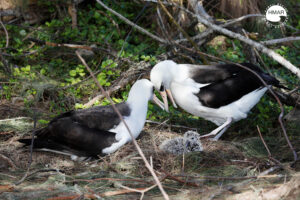
Females usually lay one egg per year in November or December, occasionally skipping a year in between (Keller et al. 2009). After the female lays the egg, she will leave the nest for several weeks to restore her body condition while the male incubates the egg. Once she returns, the pair will take turns throughout the rest of the incubation period. After about 64 days, the chick will begin a three-day process called “pipping” where the chick uses their egg tooth, a hard projection on their bill, to chip at the shell until the hole is large enough to emerge. The young bird is tended to by both parents who remain together for the first few days and then take turns 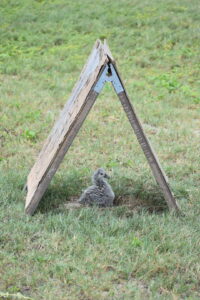 staying with the chick and foraging for food (DLNR 2005). When the female to male ratio is out of balance, occasionally two females will pair up to raise a chick. One or both of the females will mate with a neighboring male and then raise one of the eggs. While often not as successful as a female and male bond, this adaptive strategy demonstrates how same-sex pairing is better than not breeding at all (Young and VanderWerf 2014).
staying with the chick and foraging for food (DLNR 2005). When the female to male ratio is out of balance, occasionally two females will pair up to raise a chick. One or both of the females will mate with a neighboring male and then raise one of the eggs. While often not as successful as a female and male bond, this adaptive strategy demonstrates how same-sex pairing is better than not breeding at all (Young and VanderWerf 2014).
As the chick gets older, the parents will begin to leave it alone and stay away for longer periods of time, up to 17 days and traveling 3,000 miles, to gather more food (Keller et al. 2009). After five and a half months of demanding care, the chick will fledge, leaving the nest and heading out to sea, where it will care for itself for a few years before returning to a nesting colony. Much about this time is unknown to researchers.
Laysan albatross are considered near threatened as their environment and breeding grounds are under serious threat due to climate change and sea level rise (USFWS 2005). Additionally, the build-up of plastic in the ocean poses a risk as the seabirds often mistake it for food. Plastic ingestion brings harmful chemicals into the seabird's systems and can result in punctures to their digestive system leading to starvation, dehydration, and death. Plastic accumulation in the stomach can also give a false sensation of satiation, or feeling full, resulting in starvation because the individual is not gaining proper nutrition. Laysan albatross also fall victim to fishery bycatch as they are unintentionally caught in nets or miles of long line with baited hooks. Efforts to decrease the number of seabird deaths from fishery bycatch have been initiated by the United States with fairly successful results. However, globally, more efforts are necessary.
There are many ways that you can help support the Laysan albatross and their species’ survival. When in the presence of the seabird, remain at least 35 feet (10 meters) from the bird or nest, keep your dog leashed, and minimize talking and noise so as not to disturb the animal. Another way to positively impact the health of the Laysan albatross species is to reduce your use of plastic and move towards a zero-waste lifestyle. Discarded plastic often ends up in the ocean where the albatross eat it and feed it to their young. Lastly, when purchasing seafood, consider utilizing the Monterey Bay Aquarium’s Seafood Watch Program app which offers convenient information about how to choose sustainable seafood in stores and restaurants. Together, we can increase the survival of this incredible species and learn to coexist.
Hawaii Marine Animal Response (HMAR) is a first responder and rescue organization for Hawaiian monk seals, sea turtles and seabirds in need of assistance. If you see an injured, stranded, or entangled seabird on Oahu, please call the HMAR hotline at (808) 220-7802. To report a marine mammal or sea turtle of concern on Oahu, please call the HMAR hotline at (808) 220-7802. Statewide, please call (888) 256-9840. Learn more about HMAR and ways you can help here.

References and further reading:
- Keller, K., Anders, A., Shaffer, S., Kappes, M., Flint, B., & Friedlander, A. 2009. A Marine Biogeographic Assessment of the Northwestern Hawaiian Islands: 235-274.
- Meseth, E. 1975. The Dance of the Laysan Albatross, Diomedea Immutabilis. Behaviour 54 (3-4) 217-257.
- U.S. Department of Land and Natural Resources. 2005. Hawaii’s Comprehensive Wildlife Conservation Strategy.
- U.S. Fish and Wildlife Service. 2019. https://www.fws.gov/refuge/Midway_Atoll/News/Where_Is_Wisdom.html
- U.S. Fish and Wildlife Service. 2005. Seabird Conservation Plan Pacific Region.
- Young, L. and VanderWerf, E. 2014. Adaptive value of same-sex pairing in Laysan albatross. Proceedings of the Royal Society B. 281(1775). https://doi.org/10.1098/rspb.2013.2473
Hawaiʻi's Sea Turtles: Common Questions & Easy Solutions
Hawaiʻi's Sea Turtles: Common Questions & Easy Solutions
By Abigail Bearce
Have you ever seen a sea turtle on the beach or in near-shore waters?
Seven species of sea turtles exist worldwide, two of which are commonly found along the shores of the Hawaiian Islands, and one can even be seen on sandy shores. Green sea turtles are the only sea turtles recorded basking and Hawaiʻi is the only place in the world where green sea turtles bask on shore regularly - almost every day! Sea turtles have been observed basking in a few other places, such as Australia and the Galapagos Islands, but not consistently. Typically, sea turtles only leave the ocean and slowly crawl across the sand when they are laying nests. Most male sea turtles never return to land unless they are stranded! However, in Hawaiʻi both male and female green sea turtles have been reported basking year-round.
Why do green sea turtles bask on land?
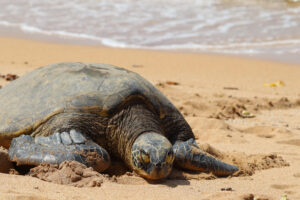 Sea turtles are ectothermic, meaning they rely on the environment to regulate their body temperature. Basking is a way to raise their body temperature (thermoregulation), rest, escape potential predators, and improve digestive and immune system functions. Sea turtle basking behavior has been correlated with sea surface temperature; when sea surface temperatures are lower, more basking occurs (Van Houton et. al., 2015). The spatial distribution of sea turtle basking is not well understood. A possible reason basking behavior is only seen consistently in Hawaiʻi may be a trait evolved over time due to how they have been protected on the islands.
Sea turtles are ectothermic, meaning they rely on the environment to regulate their body temperature. Basking is a way to raise their body temperature (thermoregulation), rest, escape potential predators, and improve digestive and immune system functions. Sea turtle basking behavior has been correlated with sea surface temperature; when sea surface temperatures are lower, more basking occurs (Van Houton et. al., 2015). The spatial distribution of sea turtle basking is not well understood. A possible reason basking behavior is only seen consistently in Hawaiʻi may be a trait evolved over time due to how they have been protected on the islands.
What to do if you see a sea turtle on the beach?
When observing a sea turtle on the beach remember to stay a respectful distance of ten feet away. The sight can be alarming for the first time if you are unaware that it is a common occurrence in Hawaiʻi. Here are some common behaviors:
- Sea turtles move slowly on land digging their flippers into the sand and thrusting themselves further up the beach and often stopping for breaks between movements.
- Sea turtles ingest a lot of sea water when they are eating so they will spit up some water because of the pressure of being on land. This is normal! Sometimes algae and seaweed, one type known as limu, is ingested while sea turtles are eating. During digestion the limu turns red and on land they sometimes regurgitate this red sea water, which can look like blood is coming out of their mouth. This is also normal behavior! If you're not sure however, please call our hotline.
- Sea turtles have special glands near their eyes used to excrete salt water, which can cause them to look like they are crying, but they are just excreting salt.
- For the most part, the sea turtle will be still, maybe opening its eyes every now and then, resting in the sun. It is very difficult to see a sea turtle breathe because of their rigid shell (carapace). However, you might hear them take a big breath, almost like they are sighing.
- Sea turtles can bask for up to 48 hours. If you are aware of a sea turtle on the beach for more than two days please call the HMAR hotline to report this behavior.
If you are concerned or notice visible injuries or fishing gear on a sea turtle, please call the statewide marine animal hotline at (888) 256-9840. Trained HMAR personnel can assess the situation and if needed, dispatch a rescue responder.
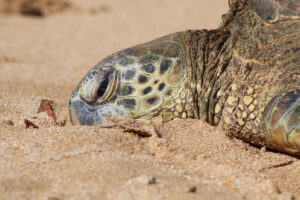
Implications of a Changing Climate
Sea turtles depend on habitats around the globe. When baby sea turtles hatch, they scurry to the ocean and embark on a journey into the open ocean, traveling with the currents. Sea turtles are known as umbrella species because they play an important role in many ecosystems they travel through. All species of sea turtles will be impacted as the climate warms and alters the landscape of the ocean.
Basking behavior of green sea turtles is also likely to change. A study examined 6 years of daily basking surveys and sea surface temperature. As mentioned earlier, when sea surface temperatures are lower, more basking occurs (Van Houtan et. al. 2015). Van Houtan et. al. anticipates sea turtle basking in Hawaiʻi could end by 2039 if sea temperatures continue to rise on the current trajectory (2015).
How you can help protect Hawaiʻi's Sea Turtles
- HMAR Hotline
If you are ever concerned about a sea turtle please report it to the HMAR hotline and trained personnel can assess the situation and dispatch a rescue responder if needed. Statewide, please call (888) 256-9840.
- Decrease emissions
In our day to day lives we can help conserve sea turtles, their incredible behavior, and beautiful habitat by decreasing our emissions. Choosing to walk, bike, or take public transportation when we have the option. A major way to reduce emissions is to buy locally, which reduces demand for transoceanic shipments of goods and also decreases the risk of boat strikes on sea turtles.
- Responsible seafood
One of the biggest threats to sea turtles is discarded fishing gear and commercial fishing operations. Sea turtles can accidentally ingest or become entangled in fishing line left on reefs or rocks causing serious injuries or death. If you see an entangled turtle do not try to disentangle it as this can cause injury or death to the sea turtle and serious injury to the person attempting to help. Instead, call the HMAR hotline as soon as possible. Know where your seafood comes from. Responsible fishers are using barbless hooks, species specific bait to reduce bycatch, and following net rules. Don’t be afraid to ask questions about the food you are buying.
Any and all of these actions help move us towards a healthy ocean ecosystem shared in sustainable harmony between protected marine species and humans. By reporting animals in distress and making small behavior changes for the planet, you are contributing to recovering populations of sea turtles. Mahalo nui for your continued support for marine life and their homes.

References and further reading:
- Van Houtan K., Halley J., Marks W. 2015. Terrestrial basking sea turtles are responding to spatio-temporal sea surface temperature patterns. Biology Letters 11(1). doi.org/10.1098/rsbl.2014.0744
- Visit our Sea Turtle Page.
Marine Debris in the Anthropocene
Marine Debris in the Anthropocene
By Kathleen Barkats
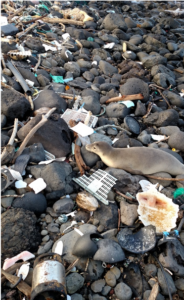 We live in an era where the marine environment is littered with debris. Marine debris can enter the ocean in a variety of ways, but it all comes from one predominant source: humans. Beaches that once appeared pristine have microplastics engrained in the sand, while fishing gear and discarded food containers float along a conveyor belt of ocean currents. As of 2018, the Great Pacific Garbage Patch, just one of several large maritime trash concentrations, is estimated to contain 79,000 metric tons of ocean plastic, with 46% being comprised of fishing gear (Lebreton et al. 2018). This issue is of enormous proportions and affects the health of humans and the ocean on a global scale.
We live in an era where the marine environment is littered with debris. Marine debris can enter the ocean in a variety of ways, but it all comes from one predominant source: humans. Beaches that once appeared pristine have microplastics engrained in the sand, while fishing gear and discarded food containers float along a conveyor belt of ocean currents. As of 2018, the Great Pacific Garbage Patch, just one of several large maritime trash concentrations, is estimated to contain 79,000 metric tons of ocean plastic, with 46% being comprised of fishing gear (Lebreton et al. 2018). This issue is of enormous proportions and affects the health of humans and the ocean on a global scale.
Human influence on terrestrial and marine ecosystems has led the scientific community to refer to the age of humanity as the Anthropocene (Zalsiwiscz et al. 2018). The Anthropocene describes a new geologic epoch with an environment dictated by growing human populations, activities, and impacts. Anthropogenic marine debris is just one threat to our ocean ecosystem – but its pervasive nature is having irreversible impacts.
Synthetic polymers, or plastics (Bergmann 2016) are among the most prevalent marine debris items. Humans developed synthetic polymers as disposable, cost-effective, and widely applicable manufacturing material. These plastic products gained traction for their convenience and durability. However, plastic is so durable that it cannot fully break down in the environment. Rather, it breaks up into smaller pieces known as microplastics, that take lifetimes to fully degrade (Bergmann 2016).
Once marine debris is seaborne, it creates a myriad of issues for marine species including entanglement, ingestion, and habitat destruction. Interactions with fishing gear can leave marine life injured, hooked, or trapped, where they are vulnerable to drowning or predation. Coral reefs are often found entangled in fishing line, which can reduce survivability and put critical habitat at risk for marine species that depend on them. Additionally, seabirds have been known to mistake plastics for food. They feed on plastic items and feel full from the bloat, but because they cannot digest plastics, the birds end up starving to death (Leeson 2016).
While charismatic megafauna such as whales, dolphins and seals draw attention to the issue, the impact of marine debris on smaller species is just as important. When plastic enters the food web at low trophic levels, its toxicity magnifies into species higher up, like top predators such as Hawaiian monk seals, sharks, whales, and humans (Bergmann 2016). Beyond the harm to human health, this also harms the fishing industries because seafood contains plastic particles.
While the issue may seem overwhelming, efforts to remove marine debris from our oceans are underway. Hawaii Marine Animal Response (HMAR) added our Marine Debris Program (MDP) to our line-up of other marine species and ocean ecosystem programs in August 2019 to help remove hazardous litter that is found in the coastal waters of Oahu. Our MDP team, comprised of staff and volunteers, conducts snorkel and SCUBA dives several times a month to physically disentangle coral heads and pick up marine trash, like derelict fishing gear that causes injuries and death to protected marine animals. Since August, and focusing our efforts in specific locations frequented by Hawaiian monk seals and sea turtles, we have removed more than 2,000 feet of monofilament fishing line, 45 hooks, and 52 weights. This is a significant impact, but each individual can contribute as well.
- Refuse Single Use.
One of the biggest steps someone can take is to refuse single-use plastic items. Reusing and recycling these materials is helpful, but reducing initial demand and consumption is the most influential. Despite a higher initial cost, sustainable alternatives are more cost-effective in the long run because there is no need to replace them.
- Dispose Responsibly.
Learn what materials are recyclable in your area. On Oahu, trash is collected, incinerated, and converted to energy at the H-POWER facility (Hawaiian Electric 2020). The goal of this process is to reduce the amount of waste entering landfill while simultaneously creating energy for the island. When we dispose properly, we limit the litter ending up in the ocean.
- Do Your Part.
By participating in removal efforts, we can make a significant difference for our ocean. There are numerous opportunities to volunteer at formal clean ups on land and in the water. Even when not at designated events, you can clean up litter as you see it. It may seem futile to pick up small pieces of trash and plastic from a beach. However, humans are the most widespread species, and when everyone takes time to remove even a little debris, the impact becomes much greater.
The Anthropocene is here, but we can still choose what our impact will be. If all 7 billion of us take small steps to make a difference, we can make lasting change for our oceans.
Click here to learn how you can participate in HMAR’s Marine Debris Program today!
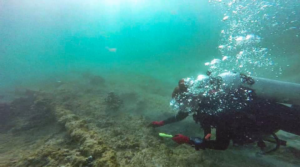
References and further reading:
- Asoh K., Yoshikawa T., Kosaki R., Marschall E. 2004. Damage to Cauliflower Coral by Monofilament Fishing Lines in Hawaii. Conservation Biology18(6): 1645-1650.
- Bergmann, Melanie. Marine Anthropogenic Litter. Springer International PU, 2016.
- Hawaiian Electric. “H-POWER (Covanta Honolulu Resource Recovery Venture).” Hawaiian Electric, 2020, www.hawaiianelectric.com/clean-energy-hawaii/our-clean-energy-portfolio/renewable-energy-sources/biomass/h-power.
- Lebreton, L., Slat, B., Ferrari, F. Sante-Rose, B., Aitken, J., Marthouse, A., Hajbane, S., Cunsolo, S., Schwarz, A., Levivier, A., Noble, K., Debeljak, P., Maral, H., Schnoeneich-Argent, R., Brambini, R., Reisser, J. 2018. Evidence that the Great Pacific Garbage Patch is rapidly accumulating plastic. Scientific Reports (8): 4666. doi:10.1038/s41598-018-22939.
- Leeson, Craig, director. A Plastic Ocean.
- Zalasiewicz, Jan, et al. "The Anthropocene." Geology Today5 (2018): 177-181.
Toxoplasmosis and Fibropapillomatosis

Unseen Impacts: Toxoplasmosis and Fibropapillomatosis
By Kathleen Barkats
In addition to its beautiful beaches, Hawaii is home to many marine animals. As a visitor or resident, it is common to experience Hawaii’s wildlife, such as sea turtles popping their heads up from the water and Hawaiian monk seals resting on the beach. Unfortunately, marine species like these face many environmental threats including debris entanglement, physical trauma, habitat loss, and many more. These important issues come to the forefront of environmental discussion because of how broadly they impact the oceans. However, there exist lesser-known issues that pose particular threats to specific species. For the Hawaiian monk seal, Neomonachus schauinslandi, toxoplasmosis is a life-threatening disease. Fibropapillomatosis is the similar disease for green sea turtles, Chelonia mydas. Human activity is likely perpetuating these diseases, which pose serious threats to both species.
Toxoplasmosis is a parasite spread by cats, the only definitive hosts (Dubey 2016). This disease can be transmitted to humans also, and is a primary concern for pregnant women where the disease can cause birth defects. In the marine environment, toxoplasmosis can impact marine mammals such as the endangered Hawaiian monk seal and dolphins.
Toxoplasmosis spreads through a specific sequence of events. The parasite is present in intermediate hosts like mice and birds and it is passed on to animals that consume these hosts. When cats predate these intermediate hosts, they consume parasitic cysts and become infected. Toxoplasmosis reproduces exclusively within cats, who shed the oocysts (the egg form of a parasite) through their feces and spread the parasite throughout the environment. Toxoplasmosis oocysts work their way into waterways that feed into the ocean. As a result, Hawaiian monk seals and dolphins can ingest the parasite through consumption of prey in the marine ecosystem.
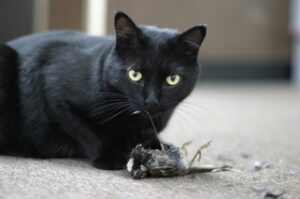 Toxoplasmosis is a major cause of death in Hawaiian monk seals in the main Hawaiian Islands. It has killed at least eight animals since 2001 (NOAA 2018) and this is very significant given the small remaining population of these endangered animals. According to the Center for Disease Control, symptoms in humans generally present as flu-like, although some infections remain asymptomatic. As such, the disease is difficult to detect and treat in any species. Seals with toxoplasmosis can face impaired reproductive, brain, and immune system functions (NOAA 2019). Animals that do not die from the disease become much more vulnerable to natural environmental stressors.
Toxoplasmosis is a major cause of death in Hawaiian monk seals in the main Hawaiian Islands. It has killed at least eight animals since 2001 (NOAA 2018) and this is very significant given the small remaining population of these endangered animals. According to the Center for Disease Control, symptoms in humans generally present as flu-like, although some infections remain asymptomatic. As such, the disease is difficult to detect and treat in any species. Seals with toxoplasmosis can face impaired reproductive, brain, and immune system functions (NOAA 2019). Animals that do not die from the disease become much more vulnerable to natural environmental stressors.
There is an incredibly large population of feral cats in Hawaii and these animals rapidly spread toxoplasmosis oocytes throughout the environment. To reduce this impact, humans should avoid feeding and interacting with feral cats as it supports the population. Instead, opt for environmentally safer alternatives like catch and release sterilization, adoption and broader feral cat management strategies. In the same vein, domesticated cats must stay indoors unless supervised. Outdoor cats can unfortunately put the lives of native fauna, like seabirds, at stake. Some countries with problematic feral cat populations, such as Australia and New Zealand, have introduced eradication operations to minimize damage to native ecosystems.
While monk seals struggle with toxoplasmosis, sea turtles face Fibropapillomatosis (FP), which is a viral infection. Both green sea turtles (honu) and hawksbill sea turtles (‘ea) live in Hawaii, with hawksbill turtles being very endangered. While HMAR responds more often to green sea turtles affected by FP, all turtle species are vulnerable to its impacts. FP is presumed to be a strain of herpes; however, there is no substantial evidence to support this theory other than the quick spreading of the virus and the fact that there is no known cure (Whitehouse 2015).
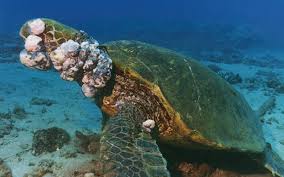 Fibropapillomatosis presents as tumors that appear on the faces, bodies, and vital organs of sea turtles. Because not all tumors are visible to the naked eye, it can be impossible to tell if green sea turtles are infected. Those with external tumors can have impaired vision or mobility, putting them in danger in the surrounding environment, while internal tumors can impair the function of vital organs. Individuals can die from these tumors whether they are internal or external, and attempts to remove tumors often become thwarted by recurrence. Humans do not yet have a clear understanding of how this disease spreads. Research from the University of Hawaii at Manoa indicates that nitrogen runoff in the nearshore ecosystem could be linked to tumor growth. Nitrogen increases the amount of the amino acid arginine in invasive algae and seaweed, which are staples in the sea turtle diet. Studies show that arginine actually promotes the FP virus (Smith and Zimmerman 2014). Chris Whitehouse proposes another theory in his 2015 overview of FP. He suggests that FP could be transmitted between honu through direct contact of uninfected turtles with infected turtles, although there is no certain conclusion.
Fibropapillomatosis presents as tumors that appear on the faces, bodies, and vital organs of sea turtles. Because not all tumors are visible to the naked eye, it can be impossible to tell if green sea turtles are infected. Those with external tumors can have impaired vision or mobility, putting them in danger in the surrounding environment, while internal tumors can impair the function of vital organs. Individuals can die from these tumors whether they are internal or external, and attempts to remove tumors often become thwarted by recurrence. Humans do not yet have a clear understanding of how this disease spreads. Research from the University of Hawaii at Manoa indicates that nitrogen runoff in the nearshore ecosystem could be linked to tumor growth. Nitrogen increases the amount of the amino acid arginine in invasive algae and seaweed, which are staples in the sea turtle diet. Studies show that arginine actually promotes the FP virus (Smith and Zimmerman 2014). Chris Whitehouse proposes another theory in his 2015 overview of FP. He suggests that FP could be transmitted between honu through direct contact of uninfected turtles with infected turtles, although there is no certain conclusion.
Unlike toxo, FP proves more challenging to prevent. According to the US Army Medical Research Institute of Infectious Disease, FP prevalence was diminished by the removal of infected animals in some areas of Hawaii. Sea turtles usually inhabit near-shore environments where pollution and runoff are often greatest. By cleaning coastal waterways and shorelines, or supporting regulation of permitted runoff, we might reduce pathogens that can cause FP to develop in the first place. In addition, reporting sightings of injured or infected sea turtles help HMAR and NOAA keep track of the prevalence and spread of this disease.
Sea turtles and Hawaiian monk seals are keystone species, so toxoplasmosis and FP impact the function of the wider Hawaiian marine ecosystem. Both are particularly susceptible to pathogens in the oceans and help indicate the health of ocean environments. Thus far, these diseases have been nearly impossible to eliminate, so humans must take preventative action to minimize the contribution to these deadly diseases. Becoming informed of the issues facing monk seals and sea turtles helps us understand the impacts of our daily choices. Supervising pets, minimizing pollution, and reporting distressed marine animal sightings are significant forms of assistance. These small adjustments bring us closer to allowing monk seals and sea turtles to thrive in the generations to come.
